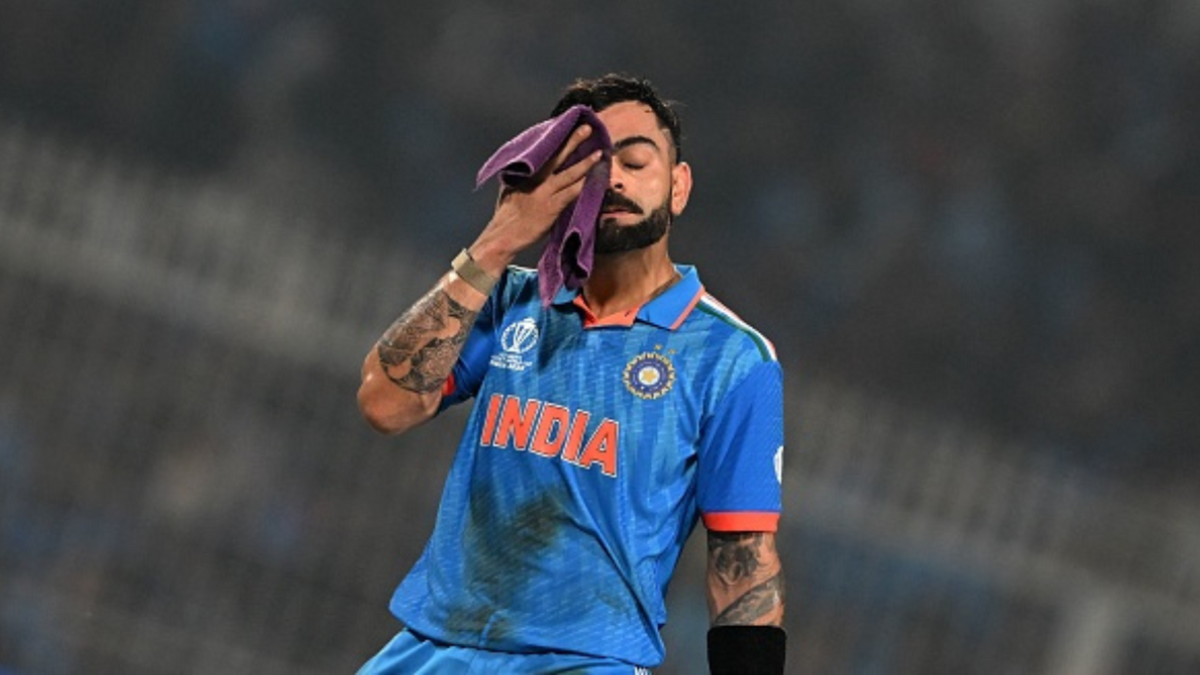
Virat Kohli was criticised by some for slowing down en route to his historic 49th ODI ton against South Africa in Kolkata but, on a tricky wicket, this is unwarranted, writes Sarah Waris.
To bet on the World Cup with our Match Centre Partners bet365 head here.
The bare facts are: Virat Kohli scored at a strike rate of 83.47, while India’s 326 came at well over a run a ball. Even taking away the 22 runs for wides, Kohli’s strike rate was only ahead of KL Rahul’s on the day. He made 26 off his last 26 balls, maintaining a run a ball in the phase in which teams try to go at tens.
This was a landmark day, equalling Sachin Tendulkar’s world record tally and securing top spot in the group with another dominant display, But as was the case with Kohli’s other century, there were grumblings in some corners over his intent. The ‘S’ word (selfishness) was used by some. But any criticism misses the bigger picture, as a deeper dive into his innings shows.
Kohli walked out to bat at 62-1 in the sixth over after Rohit Sharma had played another quickfire knock of 40 in 24 balls. The Eden Gardens, recently known for the big runs scored in the IPL, had not been conducive to big hitting in the World Cup thus far, and Rohit, realising the slowness of the track, looked to go after the faster bowlers before the spinners entered the attack, giving India a headstart.
Following his dismissal, India kept up the rhythm for a time, adding 29 runs after Rohit’s dismissal to reach 91-1 at the end of the first powerplay, with Kohli scoring successive fours off Kagiso Rabada. But the introduction of spin in the 11th over changed the momentum of the innings as run-scoring became tougher on a wicket that slowly started baring its true self.
Following Shubman Gill’s dismissal, Kohli along with Shreyas Iyer, focused on taking singles and doubles as the boundaries dried up. From the 11th over till the 30th, the Indian batters managed four fours along with a six, of which only one was hit by Kohli, against Lungi Ngidi. During this phase, Kohli played 44 balls for 26 runs against the slower bowlers, with Tabraiz Shamsi, in particular, tying him down by bowling negatively down the leg side. Kohli was also given a lifeline on 36 when Quinton de Kock failed to latch onto a tough catch down the leg side.
Iyer, on the other hand, struck at 84 against the spinners in the middle overs, making 42 in 50 balls. The roles were reversed against the quicks, with Kohli scoring at a comfortable strike rate of 83.3 in the middle, as against Iyer’s strike rate of 41.7. In a period where the India batters had to grind it out, both Iyer and Kohli found their respective strengths and focused on rotating the strike instead.
Iyer’s dismissal in the 37th over slowed down the innings further, with India only making 22 runs in the next 32 deliveries. As Rahul struggled for rhythm during his 17-ball eight, Kohli made 10 in 16. When Rahul departed, India were 249-4 in 42.1 overs, needing a flourishing end to get to a par score.
Cameos by Suryakumar Yadav and Ravindra Jadeja, who hit a combined eight fours and a six in 29 balls they faced, were contrasted with Kohli’s cautious approach, which led to question marks over his intent as he neared a milestone.
The former skipper later clarified his stance, saying the team’s message was to bat till the end with Yadav and Jadeja being given the freedom to play their shots. With Hardik Pandya also being ruled out of the World Cup, India’s batting effectively ends at No.7 with Jadeja, and if Kohli had also looked to play his strokes, India would have been in danger of ending with a score below 300, which the centurion later admitted, would not have been par.
“As the ball got older, the conditions slowed down drastically. The message was clear, keep batting around me. I was happy from that perspective. Once we got more than 315, we knew that we were above par.”
At the post-match press conference, Jadeja credited Kohli for his batting in the death, admitting that the pitch became easier to bat on in the second innings with dew around. The final scorecard could reflect otherwise, but when the team was in trouble, Kohli proceeded to bat exactly as the team wanted from him.
It wasn’t that Kohli did not look to attack in the second half. He attempted to pull the shorter balls by Shamsi and punched a couple of cover drives, but the slowness of the track ensured he failed to get power behind his hits. Realising it was not paying off, he curbed down the risks, to ensure a few extra runs on the board, instead allowing Yadav and then Jadeja to play their shots.
Kohli’s dismissal at the point could have proven to be disastrous, forcing Jadeja or Yadav to bat cautiously and deny easy singles to the tail-enders as the approach would then have changed to wicket preservation instead of run-scoring. Instead, Kohli looked to play second fiddle, allowing his partners to bat freely without letting them worry about the calibre of the batter at the other end.
India upped the ante in the end, which makes it easy to believe that Kohli’s run-a-ball phase was entirely because he was nearing his hundred. Scorecards portray only part of the story and they seldom reflect the situation of the game but his 49th should be remembered as a finely crafted ton.








